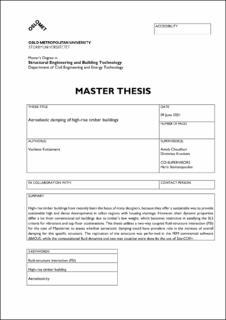| dc.description.abstract | This thesis aims to connect three different interdisciplinary engineering fields, in order to provide a holistic approach to structural design.
Real time fluid-structure interaction (FSI), requires a two-way coupling scheme where the computational fluid dynamics (CFD) solution is exported on the finite element model (FEM) as external loads and then the deformations of the FEM are imported back into the (CFD) for the next solution iteration. This thesis utilises a (FSI) for assessing the importance of aeroelastic damping in high-rise timber buildings. In addition, the amount of damping soil structure interaction (SSI) is studied by using a set of Winkler springs. For the (CFD) part, unsteady Reynolds-averaged Navier–Stokes equations were used in conjuncture with the SSTKO turbulence model, thus avoiding implementing the common LES or DES approaches. Lastly, aeroelasticity is studied by using 4 different finite elements models subjugated under 6 different wind conditions. | en_US |
